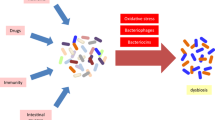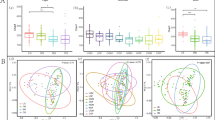Abstract
This study aims to provide an overview of the diversity of intestinal Lactobacillus among Chinese patients with hepatitis B virus (HBV)-related decompensated cirrhosis and who received liver transplant for hepatitis B cirrhosis. Fecal samples were collected from 38 healthy volunteers, 61 patients with HBV-related decompensated cirrhosis (group LC) and 74 patients who had liver transplant for hepatitis B cirrhosis (group LT). Quantitative polymerase chain reaction technology with species-specific primers was applied to investigate lactobacilli 16S rDNA in crude DNA, extracted from fecal samples. Software package Statistical Package for the Social Sciences and Palaeontological Statistics for Windows was used to analyze the data. Lactobacilli population of the two patient groups was different from the healthy control subjects, principal differences being marked decrease in the population of Lactobacillus rhamnosus (p < 0.001 for both patient groups) and reduction in the frequency of Lactobacillus fermentus (p < 0.001 for group LC and p < 0.01 for group LT). Our findings on the frequency of lactobacilli population suggested decreased diversity in groups LC and LT (compared with the healthy controls (p < 0.001 and p < 0.01, respectively)). Patients tended to have less complex fecal lactobacilli composition than the healthy controls, especially in the group LC.



Similar content being viewed by others
References
Aiba Y, Suzuki N, Kabir AM, Takagi A, Koga Y (1998) Lactic acid-mediated suppression of Helicobacter pylori by the oral administration of Lactobacillus salivarius as a probiotic in a gnotobiotic murine model. Am J Gastroenterol 93:2097–2101
Alander M, Satokari R, Korpela R, Saxelin M, Vilpponen-Salmela T, Mattila-Sandholm T, von Wright A (1999) Persistence of colonization of human colonic mucosa by a probiotic strain, Lactobacillus rhamnosus GG, after oral consumption. Appl Environ Microbiol 65:351–354
Almeida J, Galhenage S, Yu J, Kurtovic J, Riordan SM (2006) Gut flora and bacterial translocation in chronic liver disease. World J Gastroenterol 12:1493–1502
Bartosch S, Woodmansey EJ, Paterson JC, McMurdo ME, Macfarlane GT (2005) Microbiological effects of consuming a synbiotic containing Bifidobacterium bifidum, Bifidobacterium lactis, and oligofructose in elderly persons, determined by real-time polymerase chain reaction and counting of viable bacteria. Clin Infect Dis 40:28–37
Bateup JM, McConnell MA, Jenkinson HF, Tannock GW (1995) Comparison of Lactobacillus strains with respect to bile salt hydrolase activity, colonization of the gastrointestinal tract, and growth rate of the murine host. Appl Environ Microbiol 61:1147–1149
Berthier F, Ehrlich SD (1998) Rapid species identification within two groups of closely related lactobacilli using PCR primers that target the 16S/23S rRNA spacer region. FEMS Microbiol Lett 161:97–106
Billiar TR, Maddaus MA, West MA, Curran RD, Wells CA, Simmons RL (1988) Intestinal gram-negative bacterial overgrowth in vivo augments the in vitro response of Kupffer cells to endotoxin. Ann Surg 208:532–540
Brashears MM, Jaroni D, Trimble J (2003) Isolation, selection, and characterization of lactic acid bacteria for a competitive exclusion product to reduce shedding of Escherichia coli O157:H7 in cattle. J Food Prot 66:355–363
Chagnaud P, Machinis K, Coutte LA, Marecat A, Mercenier A (2001) Rapid PCR-based procedure to identify lactic acid bacteria: application to six common Lactobacillus species. J Microbiol Methods 44:139–148
Chen C, Li L, Wu Z, Chen H, Fu S (2007) Effects of lactitol on intestinal microflora and plasma endotoxin in patients with chronic viral hepatitis. J Infect 54:98–102
Chen Y, Yang F, Lu H, Wang B, Lei D, Wang Y, Zhu B, Li L (2011) Characterization of fecal microbial communities in patients with liver cirrhosis. Hepatology 54(2):562–572
Christensen HR, Frokiaer H, Pestka JJ (2002) Lactobacilli differentially modulate expression of cytokines and maturation surface markers in murine dendritic cells. J Immunol 168:171–178
Cirera I, Bauer TM, Navasa M, Vila J, Grande L, Taura P, Fuster J, Garcia-Valdecasas JC, Lacy A, Suarez MJ, Rimola A, Rodes J (2001) Bacterial translocation of enteric organisms in patients with cirrhosis. J Hepatol 34:32–37
Coeuret VDS, Bernardeau M, Gueguen MVJP (2003) Isolation, characterisation and identification of lactobacilli focusing mainly on cheeses and other dairy products. Lait 83:269–306
Dickson EM, Riggio MP, Macpherson L (2005) A novel species-specific PCR assay for identifying Lactobacillus fermentum. J Med Microbiol 54:299–303
Dominguez EA (1995) Long-term infectious complications of liver transplantation. Semin Liver Dis 15:133–138
Dunne C, Kelly P, O’Halloran S, Soden D, Bennett M, von Wright A, Vilpponen-Salmela T, Kiely B, O’Mahony L, Collins JK, O’Sullivan GC, Shanahan F (2004) Mechanisms of adherence of a probiotic Lactobacillus strain during and after in vivo assessment in ulcerative colitis patients. Microb Ecol Heal Dis 16:96–104
Fenicia L, Anniballi F, De Medici D, Delibato E, Aureli P (2007) SYBR green real-time PCR method to detect Clostridium botulinum type A. Appl Environ Microbiol 73:2891–2896
Fernandez MF, Boris S, Barbes C (2003) Probiotic properties of human lactobacilli strains to be used in the gastrointestinal tract. J Appl Microbiol 94:449–455
Haarman M, Knol J (2006) Quantitative real-time PCR analysis of fecal Lactobacillus species in infants receiving a prebiotic infant formula. Appl Environ Microbiol 72:2359–2365
Kawai Y, Saito T, Kitazawa H, Itoh T (1998) Gassericin A; an uncommon cyclic bacteriocin produced by Lactobacillus gasseri LA39 linked at N- and C-terminal ends. Biosci Biotechnol Biochem 62:2438–2440
Kinoshita H, Uchida H, Kawai Y, Kitazawa H, Miura K, Shiiba K, Horii A, Saito T (2007) Quantitative evaluation of adhesion of lactobacilli isolated from human intestinal tissues to human colonic mucin using surface plasmon resonance (BIACORE assay). J Appl Microbiol 102:116–123
Kwon HS, Yang EH, Yeon SW, Kang BH, Kim TY (2004) Rapid identification of probiotic Lactobacillus species by multiplex PCR using species-specific primers based on the region extending from 16S rRNA through 23S rRNA. FEMS Microbiol Lett 239:267–275
Lee TR, Yan CS (1997) Characterization of a partially purified bacteriocin, Fermentcin B, from Lactobacillus fermentum. Biotech Lett 19:741–744
Levitsky J (2006) Probiotics: application of “healthy” bacteria to liver transplant recipients. Hepatology 44:507–510
Li LJ, Wu ZW, Xiao DS, Sheng JF (2004) Changes of gut flora and endotoxin in rats with d-galactosamine-induced acute liver failure. World J Gastroenterol 10:2087–2090
Lu H, Wu Z, Xu W, Yang J, Chen Y, Li L (2011) Intestinal microbiota was assessed in cirrhotic patients with hepatitis B virus infection. Intestinal microbiota of HBV cirrhotic patients. Microb Ecol 61:693–703
Malinen E, Kassinen A, Rinttila T, Palva A (2003) Comparison of real-time PCR with SYBR Green I or 5′-nuclease assays and dot-blot hybridization with rDNA-targeted oligonucleotide probes in quantification of selected faecal bacteria. Microbiology 149:269–277
Matsuki T, Watanabe K, Fujimoto J, Kado Y, Takada T, Matsumoto K, Tanaka R (2004) Quantitative PCR with 16S rRNA-gene-targeted species-specific primers for analysis of human intestinal bifidobacteria. Appl Environ Microbiol 70:167–173
Matsuki T, Watanabe K, Fujimoto J, Takada T, Tanaka R (2004) Use of 16S rRNA gene-targeted group-specific primers for real-time PCR analysis of predominant bacteria in human feces. Appl Environ Microbiol 70:7220–7228
Miettinen M, Lehtonen A, Julkunen I, Matikainen S (2000) Lactobacilli and Streptococci activate NF-kappa B and STAT signaling pathways in human macrophages. J Immunol 164:3733–3740
O’Hara AM, O’Regan P, Fanning A, O’Mahony C, Macsharry J, Lyons A, Bienenstock J, O’Mahony L, Shanahan F (2006) Functional modulation of human intestinal epithelial cell responses by Bifidobacterium infantis and Lactobacillus salivarius. Immunology 118:202–215
O’Hara AM, Shanahan F (2006) The gut flora as a forgotten organ. EMBO Rep 7:688–693
Papp M, Farkas A, Udvardy M, Tornai I (2007) Bacterial infections in cirrhosis. Orv Hetil 148:387–395
Peran L, Camuesco D, Comalada M, Nieto A, Concha A, Diaz-Ropero MP, Olivares M, Xaus J, Zarzuelo A, Galvez J (2005) Preventative effects of a probiotic, Lactobacillus salivarius ssp. salivarius, in the TNBS model of rat colitis. World J Gastroenterol 11:5185–5192
Quraishy MS, Chescoe D, Mullervy J, Coates M, Hinton RH, Bailey ME (1996) Influence of the gut microflora and of biliary constituents on morphological changes in the small intestine in obstructive jaundice. HPB Surg 10:11–20
Rayes N, Seehofer D, Hansen S, Boucsein K, Muller AR, Serke S, Bengmark S, Neuhaus P (2002) Early enteral supply of lactobacillus and fiber versus selective bowel decontamination: a controlled trial in liver transplant recipients. Transplantation 74:123–127
Rayes N, Seehofer D, Theruvath T, Schiller RA, Langrehr JM, Jonas S, Bengmark S, Neuhaus P (2005) Supply of pre- and probiotics reduces bacterial infection rates after liver transplantation—a randomized, double-blind trial. Am J Transplant 5:125–130
Rinttila T, Kassinen A, Malinen E, Krogius L, Palva A (2004) Development of an extensive set of 16S rDNA-targeted primers for quantification of pathogenic and indigenous bacteria in faecal samples by real-time PCR. J Appl Microbiol 97:1166–1177
Ririe KM, Rasmussen RP, Wittwer CT (1997) Product differentiation by analysis of DNA melting curves during the polymerase chain reaction. Anal Biochem 245:154–160
Song Y, Kato N, Liu C, Matsumiya Y, Kato H, Watanabe K (2000) Rapid identification of 11 human intestinal Lactobacillus species by multiplex PCR assays using group- and species-specific primers derived from the 16S-23S rRNA intergenic spacer region and its flanking 23S rRNA. FEMS Microbiol Lett 187:167–173
Suzuki MT, Taylor LT, DeLong EF (2000) Quantitative analysis of small-subunit rRNA genes in mixed microbial populations via 5′-nuclease assays. Appl Environ Microbiol 66:4605–4614
Tacke F, Fiedler K, Trautwein C (2007) A simple clinical score predicts high risk for upper gastrointestinal hemorrhages from varices in patients with chronic liver disease. Scand J Gastroenterol 42:374–382
Tannock GW, Dashkevicz MP, Feighner SD (1989) Lactobacilli and bile salt hydrolase in the murine intestinal tract. Appl Environ Microbiol 55:1848–1851
Tannock GW, Tangerman A, Van Schaik A, McConnell MA (1994) Deconjugation of bile acids by lactobacilli in the mouse small bowel. Appl Environ Microbiol 60:3419–3420
Tannock GW, Tilsala-Timisjarvi A, Rodtong S, Ng J, Munro K, Alatossava T (1999) Identification of Lactobacillus isolates from the gastrointestinal tract, silage, and yoghurt by 16S–23S rRNA gene intergenic spacer region sequence comparisons. Appl Environ Microbiol 65:4264–4267
Vaarala O (2003) Immunological effects of probiotics with special reference to lactobacilli. Clin Exp Allergy 33:1634–1640
Veckman V, Miettinen M, Matikainen S, Lande R, Giacomini E, Coccia EM, Julkunen I (2003) Lactobacilli and streptococci induce inflammatory chemokine production in human macrophages that stimulates Th1 cell chemotaxis. J Leukoc Biol 74:395–402
Yim HJ, Lok AS (2006) Natural history of chronic hepatitis B virus infection: what we knew in 1981 and what we know in 2005. Hepatology 43:173–181
Acknowledgments
We gratefully acknowledge the physicians of the Department of Infectious Diseases and the surgeons in the Department of Surgery at the First Affiliated Hospital, College of Medicine, Zhejiang University for their collaboration and the collection of stool specimens. This study was supported by the National Basic Research Program (973) of China (no. 2009CB522400), the Zhejiang Provincial Science and Technology Bureau Project (no. 2006 C23017), the Zhejiang Chinese Medicine Administrative bureau project (no. 2009ZA012), and the Zhejiang Provincial Medical Scientific Research Foundation of China (Y200921311).
Author information
Authors and Affiliations
Corresponding author
Rights and permissions
About this article
Cite this article
Wu, ZW., Lu, HF., Wu, J. et al. Assessment of the Fecal Lactobacilli Population in Patients with Hepatitis B Virus-Related Decompensated Cirrhosis and Hepatitis B Cirrhosis Treated with Liver Transplant. Microb Ecol 63, 929–937 (2012). https://doi.org/10.1007/s00248-011-9945-1
Received:
Accepted:
Published:
Issue Date:
DOI: https://doi.org/10.1007/s00248-011-9945-1




